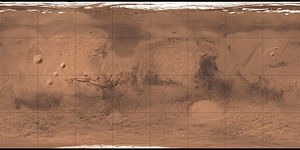Utopia Planitia
| Great Plain on Mars | ||
|---|---|---|
| Utopia Planitia | ||

|
||
| View from the lander Viking 2 of the Utopia plain. | ||
|
|
||
| position | 50 ° N , 118 ° E | |
| expansion | 3200 km | |
| history | ||
| Age | 4.2 billion years | |
| Eponym | Greek for nowhere | |
Utopia Planitia is a larger plain on the planet Mars and part of its northern lowland hemisphere.
overview
The center of the Utopia Plain is 49.7 ° north and 118 ° east. It extends mostly to the east and west; its largest diameter is 3200 kilometers. To the southeast it borders on Elysium Planitia . The name Utopia - in Greek nowhere - was taken over in 1973 from a classic albedo feature of the Martian surface, which was previously only explorable from Earth , and refers to the novel of the same name by Thomas More .
On September 3, 1976, the lander of the Viking 2 space probe landed in Utopia Planitia west of the eastern Mie crater - the most important impact crater in Utopia - and provided photos and scientific data from the surface of Mars up to 1980. With its SHARAD ground penetrating radar, the American Mars Reconnaissance Orbiter has discovered large amounts of water ice in the underground of Utopia Planitia. The underground ice layer is between 80 and 170 meters thick and is only one to ten meters below the surface.
Emergence
It is believed that the Utopia Planitia plain is itself an impact crater. About 4.2 billion years ago, Mars was hit by a number of large asteroids, with diameters between 180 km and 460 km (for comparison: the asteroid, which was probably responsible for the extinction of the dinosaurs 65 million years ago, had a diameter of only about 10 km and left the Chicxulub crater with a diameter of about 180 km in the Gulf of Mexico on the edge of the Yucatan Peninsula ).
Reception in entertainment
In the television series " Star Trek " there are the Utopia Planitia fleet yards (on the surface and in orbit), a large collection of space stations, shipyards and maintenance facilities of the United Federation of Planets , in which u. a. the starships USS Enterprise NCC-1701-D and USS Voyager were launched.
Web links
- Utopia Planitia in the Gazetteer of Planetary Nomenclature of the IAU (WGPSN) / USGS
- Astronews.com: Two valley systems in Utopia Planitia. Mars Express, August 4, 2006
- DLR: The Granicus Valles and Tinjar Valles valley systems July 28, 2006
- DLR: Was there an ocean on Mars? September 8, 2016
Individual evidence
- ^ Mars Ice Deposit Holds as Much Water as Lake Superior
- ↑ Michael Reilly: Did an asteroid kill Mars' magnetic field? MSNBC, November 19, 2008, accessed November 19, 2008 .
- ↑ George E. McGill: Buried topography of Utopia, Mars: Persistence of a giant impact depression . tape 94 , B3. J. Geophys. Res, 1989, pp. 2753-2759 ( abstract ).
